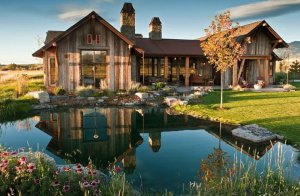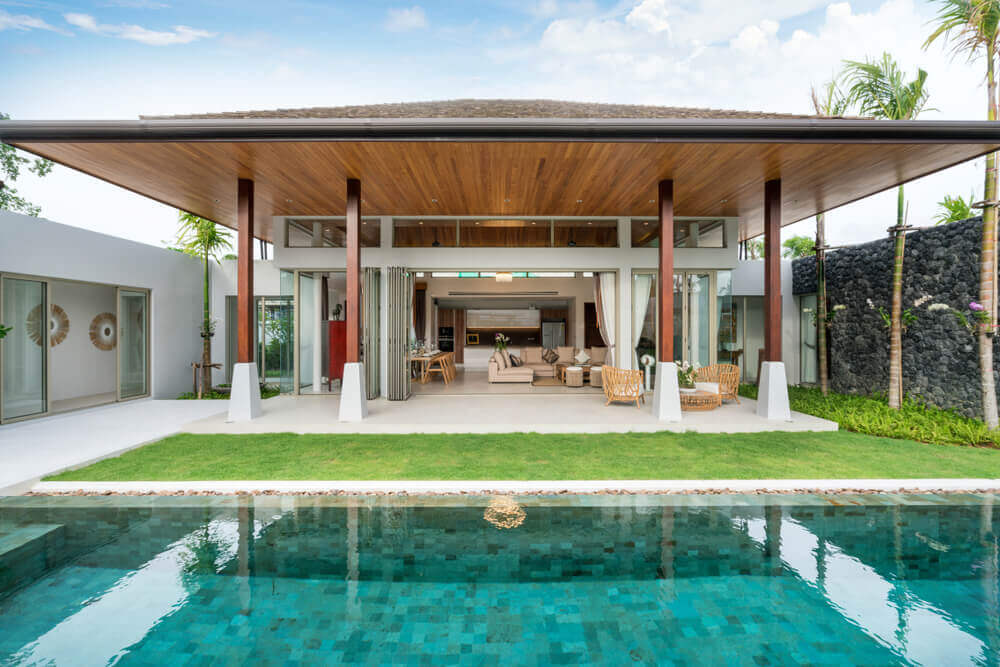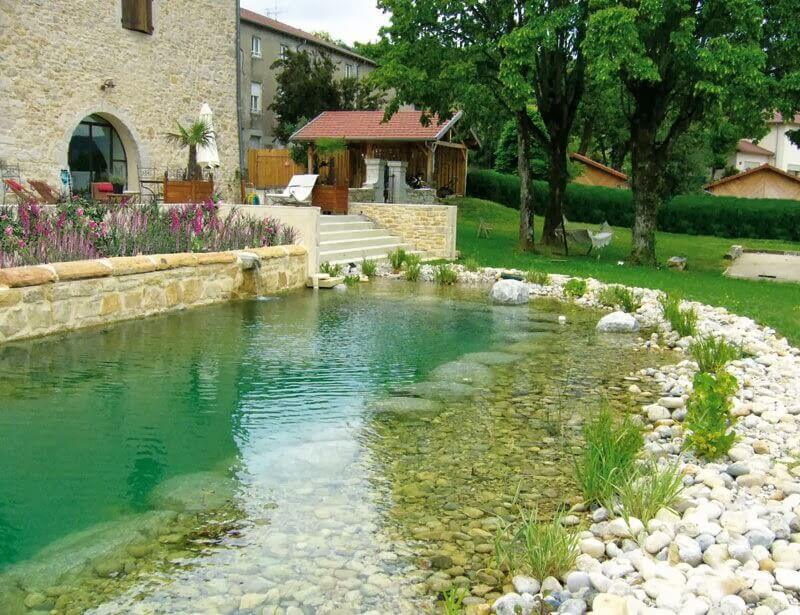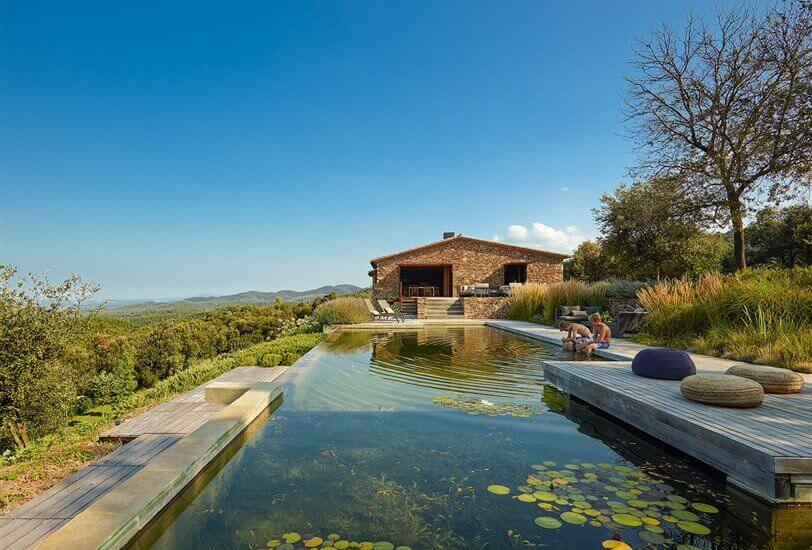The Pros and Cons of Natural Swimming Pools

Natural swimming pools are a rising trend along with the concepts of sustainable architecture and the increasingly popular ecological decoration. These swimming pools don’t use chemical purification systems.
This means these pools are always natural and plant-based. They’re very effective on an aesthetic level, and they integrate perfectly with the landscape. As with everything else, there are always pros and cons when it comes to choosing a natural swimming pool, do you know what they are?
What are natural swimming pools?

The main difference in natural pools is the purification system they require. The process involves the plants that surround and integrate with the pool.
Those plants help to oxygenate and eliminate elements that promote the growth of algae or other types of microorganisms. However, plants also have certain bacteria, like all living organisms.
To keep the elements from mixing, natural swimming pools have two different areas: the area for the purification process, and the bathing area.
In the area where the purification process occurs, there’s a division with filtration substrates. The water passes through both areas with the help of a hydraulic pump. This causes the purification plants to eliminate the microorganisms produced in the bathing area.
On the one hand, the water in these types of pools is usually not crystal clear as it is in chemical pools. Natural swimming pools need a few days for biological processes to materialize and take effect.
On the other hand, they’re really beautiful ponds, in perfect harmony with the surrounding environment. They adapt very well and cost less.
The pros of this type of pool

Among the most obvious pros of natural swimming pools is how ecological they are and the reduction in chemicals. It’s like taking a bath in a lake or natural pond, and you can even have fish that help purify the water.
The lack of chemicals is also a great way to save money, as the plants are alive and doing their job without other costly interventions. You’ll save on products and the time you invest in these processes.
Another excellent advantage is that they eliminate the risk of allergic reactions to chlorine and other chemical agents. There’s also no need to constantly change the water, natural swimming pools are generally very low maintenance.
One deep clean per year will be enough for the pool to be perfect. The format of these pools allows for freedom and adapts to the terrain. This is very interesting on an aesthetic and functional level.
The amount of water in natural pools is controlled only by natural means. The things you need to clean are the skimmer baskets, the bottom of the pool and the filter.
It’s enough to do these tasks once a year. It’s also good to take some care of the plants, but nature will do most of the work in this regard.
The negatives of natural swimming pools

In an artificially purified pool, the number of people that bathe in it is only important when talking about the space they’ll need. With natural swimming pools, it’s essential to consider the number of people that will be using it.
Plants and fish act organically, which means they don’t have aggressive processes to tackle a large number of people. This is something to take into account before going for this option.
Natural swimming pools can also be a problem if we intend small children to use them as children sometimes urinate in pools.
The natural purifying process may not completely get rid of this fluid, which could turn into a problem.
Space could be another negative for natural pools. Because they have different areas for purification and bathing they usually occupy more space than the other options.
There’s usually a wall between the two areas for hygiene and safety reasons. They generally require a space that is about 270 square feet (25 square meters) and 7 feet (ca. 2.2 m) deep for installation. This could be a drawback if you don’t have a large area of land to put the pool in.
Natural swimming pools are a rising trend along with the concepts of sustainable architecture and the increasingly popular ecological decoration. These swimming pools don’t use chemical purification systems.
This means these pools are always natural and plant-based. They’re very effective on an aesthetic level, and they integrate perfectly with the landscape. As with everything else, there are always pros and cons when it comes to choosing a natural swimming pool, do you know what they are?
What are natural swimming pools?

The main difference in natural pools is the purification system they require. The process involves the plants that surround and integrate with the pool.
Those plants help to oxygenate and eliminate elements that promote the growth of algae or other types of microorganisms. However, plants also have certain bacteria, like all living organisms.
To keep the elements from mixing, natural swimming pools have two different areas: the area for the purification process, and the bathing area.
In the area where the purification process occurs, there’s a division with filtration substrates. The water passes through both areas with the help of a hydraulic pump. This causes the purification plants to eliminate the microorganisms produced in the bathing area.
On the one hand, the water in these types of pools is usually not crystal clear as it is in chemical pools. Natural swimming pools need a few days for biological processes to materialize and take effect.
On the other hand, they’re really beautiful ponds, in perfect harmony with the surrounding environment. They adapt very well and cost less.
The pros of this type of pool

Among the most obvious pros of natural swimming pools is how ecological they are and the reduction in chemicals. It’s like taking a bath in a lake or natural pond, and you can even have fish that help purify the water.
The lack of chemicals is also a great way to save money, as the plants are alive and doing their job without other costly interventions. You’ll save on products and the time you invest in these processes.
Another excellent advantage is that they eliminate the risk of allergic reactions to chlorine and other chemical agents. There’s also no need to constantly change the water, natural swimming pools are generally very low maintenance.
One deep clean per year will be enough for the pool to be perfect. The format of these pools allows for freedom and adapts to the terrain. This is very interesting on an aesthetic and functional level.
The amount of water in natural pools is controlled only by natural means. The things you need to clean are the skimmer baskets, the bottom of the pool and the filter.
It’s enough to do these tasks once a year. It’s also good to take some care of the plants, but nature will do most of the work in this regard.
The negatives of natural swimming pools

In an artificially purified pool, the number of people that bathe in it is only important when talking about the space they’ll need. With natural swimming pools, it’s essential to consider the number of people that will be using it.
Plants and fish act organically, which means they don’t have aggressive processes to tackle a large number of people. This is something to take into account before going for this option.
Natural swimming pools can also be a problem if we intend small children to use them as children sometimes urinate in pools.
The natural purifying process may not completely get rid of this fluid, which could turn into a problem.
Space could be another negative for natural pools. Because they have different areas for purification and bathing they usually occupy more space than the other options.
There’s usually a wall between the two areas for hygiene and safety reasons. They generally require a space that is about 270 square feet (25 square meters) and 7 feet (ca. 2.2 m) deep for installation. This could be a drawback if you don’t have a large area of land to put the pool in.







